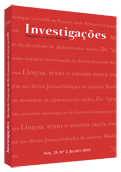Recursos Linguísticos Prosódicos como Facilitadores do Desenvolvimento da Linguagem na Clínica Fonoaudiológica do Autismo
Abstract
Este trabalho apresenta e discute questões referentes à comunicação não verbal no caso do autismo. Respaldando-nos em Marcuschi (2003), entendemos os recursos supra-segmentais, apesar da sua natureza linguística, como marcadores de caráter não-verbal, que correspondem aos contornos entoacionais, ao tom de voz, ao ritmo, aos alongamentos vocais, entre outros. Através de gravações de sessões terapêuticas fonoaudiológicas de duas crianças autistas, percebeu-se que os recursos linguísticos prosódicos desempenharam o papel de articular os segmentos do discurso, facilitar a compreensão, orientar o interlocutor durante a interação, traduzir o estado emocional dos interactantes e facilitar o acesso ao significado do discurso.References
ALVES, Luciana Mendonça et al. 2006. Aspectos temporais e entonativos na leitura e compreensão de crianças com transtorno de aprendizagem. Revista da Sociedade Brasileira de Fonoaudiologia, 11(3):151-7.
BRAZIL, David. 1987. Discussing discourse. Birmingham: English Language Research.
CHARLOP, M.H. 1983. The effects of echolalia on acquisition and generalization of receptive labeling in autistic children. Journal of Applied Behavior Analysis, 16(1):111-26.
DIONISIO, Angela Paiva; HOFFNAGEL, Judith Chambliss. 1996. Recursos
paralinguísticos e supra-segmentais em narrativas conversacionais. In: MAGALHÃES, M.I. org. As múltiplas faces da linguagem. Brasília: UNB, pp. 503-14.
FERRAZ-DE LIMA, Andréa Novaes. 2007. Recursos linguísticos e paralinguísticos na clínica fonoaudiológica do autismo. 109 f. Dissertação (Mestrado em Ciências da Linguagem) – Universidade Católica de Pernambuco, Recife.
HOWLIN, Patricia. 1982. Echolalic and spontaneous phrase speech in autistic children. Journal of Child Psychology and Psychiatry, 23(3):281-94.
JUBRAN, Clélia Cândida Abreu Spinardi. 2006. Tópico discursivo. In: JUBRAN, C.C.A.S e KOCH, I.G.V. orgs. Gramática do português culto falado no Brasil. Campinas: UNICAMP, pp. 89-132.
KANNER, Leo. 1943. Autistic disturbances of affective contact. Journal of Speech and Hearing Disorders, 2(3):217-50.
KNAPP, Mark L. 1982. La comunicación non verbal: el cuerpo y el entorno. Barcelona: Paidós Ibérica.
KOCH, Ingedore Grunfeld Vilaça. 2003. A inter-ação pela linguagem. 8. ed. São Paulo: Contexto.
______. 2006. Especificidade do texto falado. In: JUBRAN, C.C.A.S. e KOCH, I.G.V. orgs. Gramática do português culto falado no Brasil. Campinas: UNICAMP, pp. 39-46.
LOVELAND, Katherine; LANDRY, Susan. 1986. Joint attention and language in autism and developmental language delay. Journal of Autism and Developmental Disorders, 16(3):335-49.
MARCUSCHI, Luiz Antônio. 1978-1999. Sistema mínimo de notações elaborado para as transcrições do projeto sobre fala e escrita. UFPE. (mimeo).
______. 2001. Letramento e oralidade no contexto das práticas sociais e eventos comunicativos. In: SIGNORINI, I. org. Investigando a relação oral/escrito e as teorias do letramento. Campinas: Mercado das Letras, pp. 23-74.
______. 2003. Análise da Conversação. 5. ed. São Paulo: Ática.
______. 2005a. Oralidade e letramento como práticas sociais. In: MARCUSCHI, L.A. e DIONISIO, A.P. orgs. Fala e escrita. Belo Horizonte: Autêntica, pp. 31-55.
______. 2005b. A oralidade no contexto dos usos linguísticos: caracterizando a fala. In: MARCUSCHI, L.A. e DIONISIO, A.P. orgs. Fala e escrita. Belo Horizonte: Autêntica, pp. 57-84.
______. 2006. Fenômenos intrínsecos da oralidade: hesitação. In: JUBRAN, C.C.A.S. e KOCH, I.G.V. orgs. Gramática do português culto falado no Brasil. Campinas: UNICAMP, pp. 48-70.
MELLO, Edmée Brandi. 1984. Educação da voz falada. Rio de Janeiro: Atheneu.
METTER, Jeffrey. 1991. Distúrbios da fala: avaliação clínica e diagnóstico. Rio de Janeiro: Enelivros.
PACCIA, Jeanne M.; CURCIO, Frank. 1982. Language processing and forms of immediate echolalia in autistic children. Journal of Speech and Hearing Research, 25(1):42-7.
PERISSINOTO, Jacy. 2003. Linguagem da criança autista. In: PERISSONOTO, J. org. Conhecimentos essenciais para atender bem a criança com autismo. São José dos Campos: Pulso, pp. 39-44.
PRIZANT, Barry M.; DUCHAN, Judith F. 1981. The functions of immediate echolalia in autistic children. Journal of Speech and Hearing Disorders, 46(3):241-9.
PRIZANT, Barry M.; RYDELL, Patrick J. 1984. Analysis of functions of delayed echolalia in autistic children. Journal of Speech and Hearing Research, 27(2):183-92.
RIVIÈRE, A. 2002. Idea: inventario de espectro autista. Buenos Aires: Fundec.
ROBERTS, Jacqueline. 1989. Echolalia and comprehension in autistic children. Journal of Autism and Developmental Disorders, 19(2):271-81.
RYDELL, Patrick J.; MIRENDA, Pat. 1991. The effects of two levels of linguistic constraint on echolalia and generative language production in children with autism. Journal of Autism and Developmental Disorders, 21(2):131-57.
TRAVAGLIA, Luiz Carlos. 2006. O relevo no processamento da informação. In: JUBRAN, C.C.A.S e KOCH, I.G.V. org. Gramática do português culto falado no Brasil. Campinas: UNICAMP, pp. 167-215.
Downloads
Published
How to Cite
Issue
Section
License
Copyright (c) 2010 Andréa Novaes Ferraz de Lima, Wagner Teobaldo Lopes de Andrade, Margíria Ana de Moura Aguiar, Francisco Madeiro

This work is licensed under a Creative Commons Attribution 4.0 International License.
Authors who publish with Revista Investigações agree to the following terms:
Authors retain copyright and grant the journal right of first publication with the work simultaneously licensed under the Creative Commons Attribution 4.0 International (CC BY 4.0) license that allows others to share the work with an acknowledgement of the work's authorship and initial publication in this journal.
Authors are able to enter into separate, additional contractual arrangements for the non-exclusive distribution of the journal's published version of the work (e.g., post it to an institutional repository or publish it in a book), with an acknowledgement of its initial publication in this journal.
You are free to:
Share — copy and redistribute the material in any medium or format for any purpose, even commercially.
Adapt — remix, transform, and build upon the material for any purpose, even commercially.
The licensor cannot revoke these freedoms as long as you follow the license terms.
Under the following terms:
Attribution — You must give appropriate credit , provide a link to the license, and indicate if changes were made . You may do so in any reasonable manner, but not in any way that suggests the licensor endorses you or your use.
No additional restrictions — You may not apply legal terms or technological measures that legally restrict others from doing anything the license permits.

